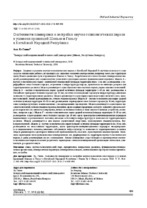| dc.contributor.author | Лу, Гопин | |
| dc.coverage.spatial | Минск | ru |
| dc.date.accessioned | 2019-01-02T10:17:51Z | |
| dc.date.available | 2019-01-02T10:17:51Z | |
| dc.date.issued | 2018 | |
| dc.identifier.citation | Лу, Гопин. Особенности планировки и застройки научно-технологических парков в условиях провинций Шаньси и Ганьсу в Китайской Народной Республике = Peculiarities of Planning and Building of Scientific and Technological Parks in Conditions of the Shanxi and Gansu Provinces in the People's Republic of China / Гопин Лу // Наука и техника. – 2018. – №6. – С. 490-496. | ru |
| dc.identifier.uri | https://rep.bntu.by/handle/data/48413 | |
| dc.description.abstract | Создание и развитие научно-технологических парков в Китайской Народной Республике используется как
средство активизации районов, нуждающихся в социально-экономическом развитии, например таких, как территории
вдоль Нового шелкового пути в провинциях Шаньси и Ганьсу. Разработаны пять типов базовых планировочных моделей, рекомендуемых для создания научно-технологических парков разного функционального профиля. Модель А – научно-технологические парки с компактной планировкой (площадь территории менее 2 кв. км), размещаемые в периферийных зонах больших городов, встроенные в инфраструктуру города, практически не имеющие резервов для
территориального развития. Модель рекомендуется для образовательно-научных парков, парков высоких технологий.
Модель Б – научно-технологические парки средней величины (площадь территории 2–10 кв. км), размещаемые в
ближайших пригородах больших городов (до 10 км), частично использующие городскую инфраструктуру, имеющие
возможность территориального развития. Модель рекомендуется для парков производственно-логистических, высоких технологий, легкой промышленности, точного машиностроения. Модель В – научно-технологические парки средней величины (площадь территории 10–20 кв. км), размещаемые в пригородных зонах больших городов (до 30 км), территориально и инфраструктурно взаимосвязанные с международными аэропортами. Модель рекомендуется для парков высоких технологий, точного машиностроения, биохимии, производящих продукцию, которую экономически целесообразно перевозить на самолетах (смартфоны, оптико-волоконная техника и иные высокотехничные устройства, косметика, лекарства и др.). Модель Г – научно-технологические парки средней величины (площадь территории 10–20 кв. км), размещаемые в пригородных зонах больших городов (до 30 км) вдоль транспортно-коммуникационных коридоров национального и регионального значения, имеющие собственную инфраструктуру и возможность территориального развития. Модель рекомендуется для парков строительной индустрии, транспортного машиностроения, био и агротехнологий. Модель Д – научно-технологические парки большой величины (площадь территории более 20 кв. км), размещаемые на межселенных территориях, вдоль транспортно-коммуникационных коридоров международного и национального значения, имеющие собственную инфраструктуру и возможность территориального развития. Модель рекомендуется для парков химической промышленности, тяжелого, транспортного машиностроения. Выявлены характерные типы функционально-планировочных зон, формируемых на территории научно-технологических парков, и даны рекомендации по их соотношению. Анализ планировки существующих и проектируемых научно-технологических парков позволил разработать характерные схемы их планировочной организации: полосовую, компактную, рассредоточенную. | ru |
| dc.language.iso | ru | ru |
| dc.publisher | БНТУ | ru |
| dc.title | Особенности планировки и застройки научно-технологических парков в условиях провинций Шаньси и Ганьсу в Китайской Народной Республике | ru |
| dc.title.alternative | Peculiarities of Planning and Building of Scientific and Technological Parks in Conditions of the Shanxi and Gansu Provinces in the People's Republic of China | ru |
| dc.type | Article | ru |
| dc.identifier.doi | 10.21122/2227-1031-2018-17-6-489-496 | |
| local.description.annotation | Creation and development of scientific and technological parks in the People's Republic of China is used as a means of activating areas in need of socio-economic development, for example such territories as along the New Silk Road in Shanxi and Gansu provinces. Five types of basic planning models recommended for creation of scientific and technological parks of different functional profiles have been developed in the paper. Model A comprises scientific and technological parks with a compact layout (area of less than 2 square kilometers) located in the peripheral zones of large cities built into the city's infrastructure and they do not have practically reserves for territorial development. The model is recommended for creation of educational and scientific parks and high-tech parks. Model B comprises scientific and technological parks of medium size (area of their territory – 2–10 square kilometers) located in the nearest suburbs of large cities (up to 10 km) and these parks partially use urban infrastructure having the possibility for territorial development. The model is recommended for creation parks of industrial-logistics, high technology, light industry, precision engineering. Model C comprises scientific and technological parks of medium size (area of 10–20 square kilometers) located in the suburbs of large cities (up to 30 km), geographically and infrastructurally interconnected with international airports. The model is recommended for creating parks of high-tech, precision engineering, biochemistry that produce products which are economically expedient to be transported by airplanes (smart phones, optical fiber equipment, other high-tech devices, cosmetics, medicines, etc.). Model D comprises scientific and technological park of medium size (area of 10–20 square kilometers) located in the suburbs of large cities (up to 30 km) along transport and communication corridors of national and regional importance with its own infrastructure and territorial development opportunities. The model is recommended for creation of parks in construction industry, transport engineering, bio- and agro-technologies. Model E comprises large scale scientific and technological parks (with area of more than 20 square kilometers) located in intersettlement territories along transport and communication corridors of international and national importance with its own infrastructure and territorial development opportunities. The model is recommended for creation of parks for chemical industry, heavy and transport engineering. The paper has made it possible to identify common types of functional-planning zones formed on the territory of scientific and technological parks and it provides recommendations on their correlation. Analysis of the layout for existing and projected scientific and technological parks has allowed to develop characteristic schemes of their planning organization: band, compact, dispersed. | ru |

